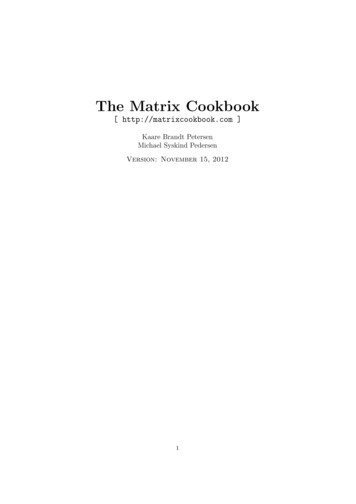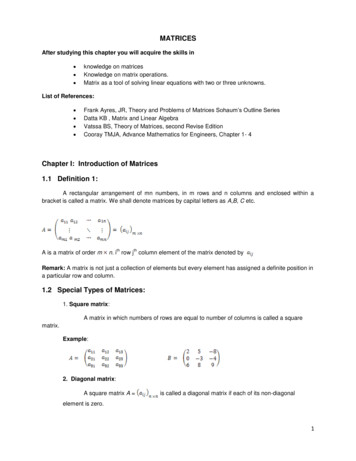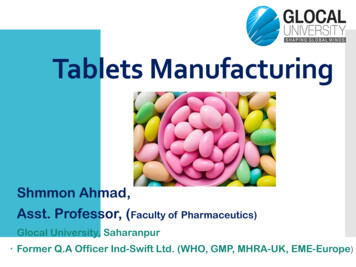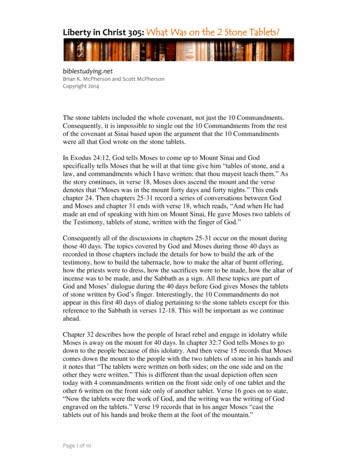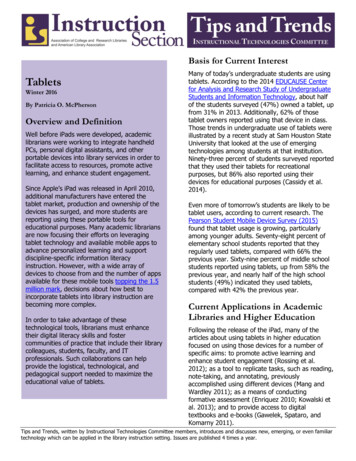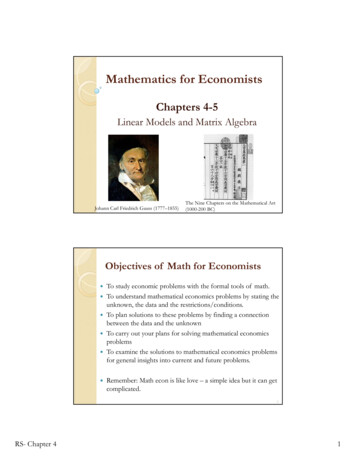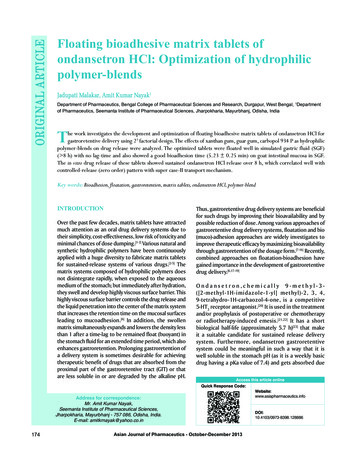
Transcription
ORIGINAL ARTICLEFloating bioadhesive matrix tablets ofondansetron HCl: Optimization of hydrophilicpolymer‑blendsJadupati Malakar, Amit Kumar Nayak1Department of Pharmaceutics, Bengal College of Pharmaceutical Sciences and Research, Durgapur, West Bengal, 1Departmentof Pharmaceutics, Seemanta Institute of Pharmaceutical Sciences, Jharpokharia, Mayurbhanj, Odisha, IndiaThe work investigates the development and optimization of floating bioadhesive matrix tablets of ondansetron HCl forgastroretentive delivery using 23 factorial design. The effects of xanthan gum, guar gum, carbopol 934 P as hydrophilicpolymer‑blends on drug release were analyzed. The optimized tablets were floated well in simulated gastric fluid (SGF)( 8 h) with no lag‑time and also showed a good bioadhesion time (5.23 0.25 min) on goat intestinal mucosa in SGF.The in vitro drug release of these tablets showed sustained ondansetron HCl release over 8 h, which correlated well withcontrolled‑release (zero order) pattern with super case‑II transport mechanism.Key words: Bioadhesion, floatation, gastroretention, matrix tablets, ondansetron HCl, polymer‑blendINTRODUCTIONOver the past few decades, matrix tablets have attractedmuch attention as an oral drug delivery systems due totheir simplicity, cost‑effectiveness, low risk of toxicity andminimal chances of dose dumping.[1‑2] Various natural andsynthetic hydrophilic polymers have been continuouslyapplied with a huge diversity to fabricate matrix tabletsfor sustained‑release systems of various drugs.[2‑5] Thematrix systems composed of hydrophilic polymers doesnot disintegrate rapidly, when exposed to the aqueousmedium of the stomach; but immediately after hydration,they swell and develop highly viscous surface barrier. Thishighly viscous surface barrier controls the drug release andthe liquid penetration into the center of the matrix systemthat increases the retention time on the mucosal surfacesleading to mucoadhesion.[6] In addition, the swollenmatrix simultaneously expands and lowers the density lessthan 1 after a time‑lag to be remained float (buoyant) inthe stomach fluid for an extended time period, which alsoenhances gastroretention. Prolonging gastroretention ofa delivery system is sometimes desirable for achievingtherapeutic benefit of drugs that are absorbed from theproximal part of the gastroretentive tract (GIT) or thatare less soluble in or are degraded by the alkaline pH.Thus, gastroretentive drug delivery systems are beneficialfor such drugs by improving their bioavailability and bypossible reduction of dose. Among various approaches ofgastroretentive drug delivery systems, floatation and bio(muco)‑adhesion approaches are widely investigates toimprove therapeutic efficacy by maximizing bioavailabilitythrough gastroretention of the dosage form.[7‑16] Recently,combined approaches on floatation‑bioadhesion havegained importance in the development of gastroretentivedrug delivery.[6,17‑19]Ondansetron,chemically ‑yl] methyl)‑2, 3, 4,9‑tetrahydro‑1H‑carbaozol‑4‑one, is a competitive5‑HT3 receptor antagonist.[20] It is used in the treatmentand/or prophylaxis of postoperative or chemotherapyor radiotherapy‑induced emesis.[21,22] It has a shortbiological half‑life (approximately 5.7 h)[23] that makeit a suitable candidate for sustained release deliverysystem. Furthermore, ondansetron gastroretentivesystem could be meaningful in such a way that it iswell soluble in the stomach pH (as it is a weekly basicdrug having a pKa value of 7.4) and gets absorbed dueAccess this article onlineQuick Response Code:Address for correspondence:Mr. Amit Kumar Nayak,Seemanta Institute of Pharmaceutical Sciences,Jharpokharia, Mayurbhanj ‑ 757 086, Odisha, India.E‑mail: amitkrnayak@yahoo.co.in174Asian Journal of Pharmaceutics - October-December 0973-8398.128886
Malakar and Nayak: Floating bioadhesive matrix tablets of ondansetron HClto remain unionized at the site of absorption. In the presentinvestigation, floating‑bioadhesive matrix tablets containingondansetron HCl for gatroretentive delivery were developedand evaluated. For the development of floating‑bioadhesivematrix tablets, blends of xanthan gum, guar gum and carbopol934 P were used. Recently, the use of polymer combination asblends to prolong the drug release rate from the matrix tabletshave become more popular, which may show performanceimprovements over the individual polymers.[1,2,6,24]Conventionally, pharmaceutical product formulators developvarious formulations by altering one variable at a time. Thismethod is time‑consuming and laborious. However, manyexperiments not succeed in their purpose because theyare not properly thought out and designed, and even thebest data analysis cannot compensate the lack of planning.Thus, formulators frequently face the challenge for searchingappropriate setting of variables that will produce the productwith optimum properties. It is therefore important to understandthe influence of formulation variables on the formulation qualitywith a minimal number of trials and subsequent selection offormulation variables to find optimal formula.[25] Optimizationby means of statistical experimental design methodologies hasbeen widely applied by designing a set of experiments that willreliably measure the measure the response variables, fittingmathematical models to the data, conducting appropriatestatistical test to assure that the best possible models chosenand determining values of variables to produce products withoptimal quality.[26] Factorial designs are considered to be themost effective in estimating the effects of various formulationvariables with minimum experimentation and time, where allfactors are studied in all possible combinations.[14] Based onthe factorial design, the optimization technique encompassesthe generation of model equations for investigated responsesover the experimental design to determine the settings offactor values to achieve optimum formulation (s).[10] In thisstudy, a 23 factorial design‑based computer‑aided optimizationwas employed to investigate the effects of various hydrophilicpolymers (namely, xanthan gum, guar gum, carbopol 934 P)as blends to develop a floating‑bioadhesive matrix tablets forsustained gastroretentive ondansetron HCl release.MATERIALS AND METHODSMaterialsOndansetron was a gift sample form Albert‑David Pvt. Ltd.,India. Guar gum, xanthan gum, carbopol 934 P, lactose,microcrystalline cellulose and magnesium stearate wereobtained from commercial sources. All chemicals andreagents used were of analytical grade.Preparation of ondansetron HCl floating bioadhesivematrix tabletsOndansetron HCl floating bioadhesive matrix tablets of wereprepared by the direct compression method after propermixing of suitable ratios various polymer‑blends and othersexcipients. Ondansetron HCl (20 mg), various hydrophilicpolymer‑blends and other excipients (lactose 70 mg,microcrystalline cellulose 20 mg, magnesium stearate 10 mg)were first passed through sieve #80. Then drug and allthe materials were uniformly mixed and compressed onsingle punch tablet machine (Cadmach Machinery Co.Pvt. Ltd., India) using 9 mm round and concave punches(for batch size of 50 tablets).Experimental designA 23 (three‑factor and two‑level) full factorial design wasemployed for the optimization of ondansetron HCl floatingbioadhesive matrix tablets. Amount of hydrophilic polymers inpolymer‑blend viz. Amount of xanthan gum (X1), guar gum (X2)and carbopol 934 P (X3) as the prime selected independentvariables (factors), which were varied at two levels (low andhigh). Different trial formulations of ondansetron HCl floatingbioadhesive matrix tablets were prepared according to thetrial proposal of 23 factorial design. The formulation chartfor all proposed trial formulations is presented in Table 1.The cumulative drug releases after 2 h (R2h, %) and after 8 h(R8h, %) were measured as dependent variables (responses) andtheir dependency on independent variables and statisticalexperimentation. Design‑Expert 8.0.6.1 software (Stat‑Ease Inc.,USA) was used for generation and evaluation of the statisticalexperimental design. The matrix of the design includinginvestigated factors and responses are shown in Table 2.For optimization, effects of various independent variablesupon measured responses were modeled using followingmathematical model equation, generated by 23 factorialdesign:[25]Y b o b 1 X1 b 2 X2 b 3 X3 b 4 X1 X2 b 5 X1 X3 b 6 X2 X3 ,where Y is the dependent variable, while bo is the intercept,b1, b2, b3, b4, b5, b6 and b7 are regression coefficients; X1, X2and X3 are independable variables; X1X 2, X2X 3, and X1X 3 areinteraction between variables. One‑way ANOVA was appliedto estimate the significance of the model (P 0.05) andindividual response parameters.Determination of drug contentA total of 20 tablets from each formulation batch wereweighted and powdered. The tablet powder equivalent to20 mg of ondansetron HCl was taken and transferred to100 ml of volumetric flask. Then, the volume was made up to100 ml with 0.1 N HCl. Vigorous shaking was done to dissolvethe powdered material in 0.1 N HCl. Samples were filteredusing filter paper No. 40. After proper dilution, absorbancevalues were measured at the maximum wavelength (λmax)using an ultraviolet‑visible (UV‑VIS) spectrophotometer(Thermo Spectronic UV‑1, USA) at 249 nm.Weight variation determinationA total of 20 tablets from each batch were sampled andaccurately weighed using an electronic analytical balance.Asian Journal of Pharmaceutics - October-December 2013175
Malakar and Nayak: Floating bioadhesive matrix tablets of ondansetron HClTable 1: 23 factorial design of hydrophilic polymer‑blendsand their observed response values along with codedvalues in brackets (other ingredients of tablets were 20 mgondansetron HCl, 70 mg lactose, 20 mg microcrystallinecellulose and 20 mg magnesium stearate)Code XanthanGuar CarbopolResponsesgumgum934 PR2h (%)a,c R8h (%)b,c(mg) X1 (mg) X2 (mg) X3F‑1F‑2F‑3F‑4F‑5F‑6F‑7F‑880.00 ( 1)80.00 ( 1)80.00 ( 1)50.00 ( 1)80.00 ( 1)50.00 ( 1)50.00 ( 1)50.00 ( 1)80.00 ( 1)80.00 ( 1)50.00 ( 1)50.00 ( 1)50.00 ( 1)80.00 ( 1)50.00 ( 1)80.00 ( 1)60.00 ( 1)30.00 ( 1)30.00 ( 1)30.00 ( 1)60.00 ( 1)60.00 ( 1)60.00 ( 1)30.00 ( 1)9.28 1.269.45 1.129.14 1.1812.26 1.2910.68 1.217.96 1.156.01 1.0515.73 1.5156.89 2.2565.65 2.7563.56 2.0965.65 2.4567.08 2.8264.41 2.5269.96 2.7876.44 2.91R2h (%): Cumulative drug release after 2 h, bR8h (%): Cumulative drug release after 8 h,Mean SD; n 3, HCl: Hydrochloride, SD: Standard deviationacTable 2: Summary of ANOVA for response parametersSourceSum of dfaMeanF valueP FsquaresquareFor R2h (%)bModel60.01610.002216.36 79X320.00120.004432.76 0.0096X1X25.3015.301173.96 0.0186X1X329.61129.616561.00 0.0079X2X31.3011.30289.000.0374For R8h .52 0724X2X379.57179.571418.03 0.0169df: Degree of freedom, bR2h (%): Cumulative drug release after 2 h, cR8h (%): Cumulativedrug release after 8 h, X1, X2 and X3 represent the amount of xanthan gum, guar gumand carbopol 934 P in mg, respectively, X1X2, X1X3 and X2X3 are their interaction effects,ANOVA: Analysis of varianceaThe weight variation (%) was calculated as: [1]Weight variation(%) Standard deviation (SD) 100Mean weight(1)Hardness testingPfizer hardness tester was used to determine the hardness ofprepared tablets. 6 tablets from each formulation batches wereplaced in between the spindle and anvil. The desired pressureneeded to hold the tablet in position is applied by movingthe screw knob in clock wise direction thereafter the scale ismoved so that the indicator is fixed at zero. The pressure is thenapplied until the tablet breaks. The reading was noted, whichindicate the pressure at which tablets break up in to fragments.176Swelling studyThe swelling behavior of tablets was carried out in dissolutionapparatus type‑II, USP (Campbell Electronics, India) in900 ml of simulated gastric fluid (SGF), pH 1.2, which wasmaintained at 37 0.5 C with rotation of 50 rpm. It was doneby weighing the tablet weight at selected regular intervals.Percentage (%) swelling of the tablet was calculated by thefollowing equation:[16]% Swelling ([Wt W0]/W0) 100, where Wt is the weight ofthe swollen tablet and W0 is the initial weight of the tablet.In vitro floatation studyThe in vitro floating ability of prepared tablets was determinedusing dissolution apparatus type‑II, USP (Campbell electronics,India).[11] A total of 3 tablets from each formulation batchwere placed in the dissolution vessels containing 500 mlSGF (SGF, pH 1.2) and set the system at 37 0.5 C for 8 hat 50 rpm rotating speed. The time required to float at thesurface of dissolution medium (lag‑time) and duration ofbuoyancy were calculated.Ex vivo bioadhesion studyEx vivo bioadhesion study was performed by ex vivo wash‑offmethod.[6] Freshly excised pieces of goat intestinal mucosa(2 cm 2 cm) (collected from slaughterhouse) were mountedon the stainless steel slide, connected with a suitablesupport. Single tablet was placed on to the wet and rinsedtissue specimen and immediately thereafter the supportwas hung to the arm of the USP tablet disintegrating testmachine. When the disintegrating machine was operated,the tissue specimen was given a slow, regular up and downmovement in 900 ml SGF, pH 1.2 contained in a 1 liter vesselof the machine at 37 0.5 C. The time for the detachmentof the test tablet from the tissue specimen after starting theoperation of the machine was measured as bioadhesion time.In vitro release studyThe in vitro release of prepared ondansetron HCl matrixtablets was tested using dissolution apparatus type‑II,USP (Campbell Electronics, India). Tablets were placedinto 900 ml of SGF (pH 1.2), maintained at 37 0.5 Cand 50 rpm paddle speed. A total volume of 5 ml ofaliquots was collected at regular time intervals and thesame amount of fresh dissolution medium was replacedinto dissolution vessel to maintain the sink conditionthroughout the experiment. The collected aliquots werefiltered and further diluted suitably to analyze using aUV‑VIS spectrophotometer (Thermo Spectronic UV‑1, USA)by measuring absorbance at λmax of 249 nm.Analysis of in vitro drug release kinetics and mechanismTo analyze the mechanism of drug release from theseondansetron HCl matrix tablets, the in vitro dissolution datawere fitted to various mathematical models such as zeroorder, first order, Higuchi and Korsmeyer‑Peppas models.[1,9,11]Asian Journal of Pharmaceutics - October-December 2013
Malakar and Nayak: Floating bioadhesive matrix tablets of ondansetron HClZero order Model: F K0 t, where F represents the fractionof drug released in time t, and K0 is the apparent release rateconstant or zero‑order release constant.in Table 2, indicated that all models were significant (P 0.05) for all response parameters investigated. The modelequation relating R2h (%) as response became:First order Model: Ln (1‑F) K1st t, where F represents thefraction of drug released in time t, and K1 is the first‑orderrelease constant.R2h (%) 18.78 1.78 10 2 X1 0.35 X 2 0.54 X3 3.61 10 3 X1X 2 8.5 10 3 X1X3 1.79 10 3 X2X3 (R2 0.9999;F 2216.36; P 0.05).Higuchi Model: F KH t, where F represents the fraction ofdrug released in time t, and KH is the Higuchi dissolutionconstant.Another polynomial equation relevant to R8h (%) as responsebecame:Korsmeyer‑Peppas Model: F KP t , where F represents thefraction of drug released in time t, KP is the rate constantand n is the release exponent, this indicates the drug releasemechanism.nAgain, the Korsmeyer‑Peppas model has been employedin the in vitro drug release behavior analysis of variouspharmaceutical formulations to distinguish between variousreleases mechanisms: Fickian release (diffusion‑controlledrelease), non‑Fickian release (anomalous transport) andcase‑II transport (relaxation‑controlled release). Whenn 0.5, the drug release is Fickian. The n value between 0.5and 1.0 is defined as non‑Fickian release. When n 1.0, it iscase‑II transport and this involves polymer dissolution andpolymeric chain enlargement or relaxation.[11]Statistical analysisStatistical optimization was performed using Design‑Expert8.0.6.1 software (Stat‑Ease Inc., USA). All measured data areexpressed as mean SD and each measurements were donein triplicate (n 3).RESULTS AND DISCUSSIONOptimization by 23 factorial designFactorial design is an experimental design by which thefactors all factors involved in a process are studied inall possible combinations by analyzing the influence ofindividual variables and their interactions using minimumexperiments. [27] Thus, the construction of factorialdesign involves the selection of factors and the choice ofresponses. A total 8 trial formulations of ondansetron HClmatrix tablets were proposed by the 23 factorial designfor three independent variables: Amount of xanthan gum(X1), guar gum (X2) and carbopol 934 P (X3), which werevaried at two different levels (high and low). The effectsof these independent variables on R2h, % and R8h, % wereinvestigated as optimization response parameters in thecurrent investigation. Overview of the 23 factorial design forthe experimental trial and observed responses is presentedin Table 1. The Design‑Expert 8.0.6.1 (Stat‑Ease Inc., USA)software provided suitable polynomial model equationsinvolving individual main factors and interaction factorsafter fitting these data. The results of ANOVA, as shownR8h (%) 35.77 9.69 10 3 X1 0.93X2 0.56 X3 5.52 10 3 X1X2 3.26 10 3 X1X3 1.4 10 2 X2X3 (R2 0.9997;F 663.73; P 0.05).The final model equations were confirmed by eliminating thenon‑significant term (P 0.05) in polynomial equations,[1]and they are:R2h (%) 18.78 1.78 10 2 X1 0.35 X 2 0.54 X3 3.61 10 3 X1 X2 8.5 10 3 X1 X3 1.79 10 3 X2 X3, andR8h (%) 35.77 9.69 10 3 X1 0.56 X3 5.52 10 3 X1X2 1.4 10 2 X2X3.Each response coefficient was studied for its statisticalsignificance by Pareto charts as shown in Figure 1a and b.These charts depicted the statistical significance of eachresponse coefficient. Coefficients with t values of effectsabove the Bonferroni line are designated as significantcoefficient; coefficients with t values of effects betweenBonferroni line and t limit line are termed as coefficientslikely to be significant, while coefficients with t values ofeffects below the t‑limit line is statistically insignificantcoefficient.[28] Therefore, these charts became functionalto establish ANOVA results for easy comprehensible onethroughout elimination of insignificant (P 0.05) terms fromboth polynomial equations.[1]The influences of main effects (factors) on responses (here,R2h, and R8h) were further elucidated by response surfacemethodology. Response surface methodology is a widelyproficient approach in the development and optimizationof drug delivery devices. [10,12,14,29] The purpose of theresponse surface methodology is to understand a modelas fully as possible effect of factors and their levels, overthe whole of the experimental domain, and to predict theresponse inside the domain. In addition, it can be usedfor optimizing a formula (i.e. maximizing one or more ofthe responses, keeping the formulation variable settingwithin a satisfactory range), carrying out simulations withthe model equations and plotting the responses.[30] Thethree‑dimensional response surface graph is very usefulin learning about the main and interaction effects of theindependent variables (factors), whereas two‑dimensionalcontour plot gives a visual representation of values of theAsian Journal of Pharmaceutics - October-December 2013177
Malakar and Nayak: Floating bioadhesive matrix tablets of ondansetron HClresponse.[1,10] The three‑dimensional response surface plotsand their corresponding contour plots relating R2h andR8h were presented in Figures 2‑7. The three‑dimensionalresponse surface plots and their corresponding contour plotsrelating R2h and R8h indicate their deceased values with theincrement of the amount of xanthan gum and carbopol 934 Pin ondansetron HCl matrix tablets mainly.A numerical optimization technique based on the desirabilityapproaches was employed to achieve new optimizedformulation with desired responses. [10] This adoptedoptimization technique also affirmed the desirable ranges ofresponse parameters to develop a formulation of desired quality.The optimal values of responses were obtained by numericalanalysis using the the Design‑Expert 8.0.6.1 (Stat‑Ease Inc.,USA) software based on the criterion of desirability. Thedesirable ranges of the independable variables (factors) wererestricted to 80 X1 90 mg, 80 X2 90 mg and 50 X3 60mg; whereas the desirable ranges of responses were limited toas 9 R2h 10%, and 50 R8h 55%. In order to evaluate theoptimization capability of these models generated accordingto the results of 23 factorial design, optimized ondansetronHCl matrix tablets was prepared by direct compression methodusing one of the selected optimal process variable settingsproposed by the experimental design. The selected optimalprocess variable setting used for the formulation of optimizedmatrix tablets were X1 81.69 mg, X2 86.14 mg and X3 59.31 mg. Table 3 lists the results of experiments done withabFigure 1: (a) Pareto chart relating R2h (%), and (b) Pareto chart relating R8h (%)abFigure 2: Effect of amounts of xanthan gum and guar gum on R2h (%), presented by response surface plot (a), and contour plot (b)abFigure 3: Effect of amounts of xanthan gum and carbopol 934 P on R2h (%), presented by response surface plot (a), and contour plot (b)178Asian Journal of Pharmaceutics - October-December 2013
Malakar and Nayak: Floating bioadhesive matrix tablets of ondansetron HClabFigure 4: Effect of amounts of guar gum and carbopol 934 P on R2h (%), presented by response surface plot (a), and contour plot (b)abFigure 5: Effect of amounts of xanthan gum and guar gum on R8h (%), presented by response surface plot (a), and contour plot (b)abFigure 6: Effect of amounts of xanthan gum and carbopol 934 P on R8h (%), presented by response surface plot (a), and contour plot (b)abFigure 7: Effect of amounts of guar gum and carbopol 934 P on R8h (%), presented by response surface plot (a), and contour plot (b)Asian Journal of Pharmaceutics - October-December 2013179
Malakar and Nayak: Floating bioadhesive matrix tablets of ondansetron HClpredicted responses by the mathematical model and thoseactually observed. The optimized ondansetron HCl matrixtablets (F‑O) showed R2h of 9.49 1.02% and R8h of 56.73 2.65% within small error‑values (less than 5), indicating thatmathematical models achieved from the full 23 factorial designwere well fitted.Drug content and weight variationAll the matrix tablets contained ondansetron HCl within therange of 97.68 1.03‑99.44 0.97 [Table 4]. Therefore, thedrug content results ascertain the presence of ondansetronHCl in the appropriate amount in all the matrix tablets. Weightvariation does serve as a pointer to good manufacturingpractices maintained by the manufacturers as well as theamount of active pharmaceutical ingredient contained in theformulation. All these matrix tablets met the USP specificationsfor weight uniformity.[31] The weight variation of these tabletsvaried from 1.92 0.20 to 3.01 0.28% and none of thetablets deviated by up to 5% from their mean weight [Table 4].The uniform drug content and weight of the formulatedondansetron HCl matrix tablets indicate the uniform mixingof ondansetron HCl with other ingredients used.HardnessThe hardness test for ondansetron HCl matrix tablets wasperformed to assess the ability of tablets to withstandhandling without fracturing or chipping. A force of about4 kg/cm2 is the minimum requirement for a satisfactoryhardness of tablets.[32] The results of the hardness testingshowed that hardness of all these matrix tablets were withinthe range between 4.03 0.08 to 4.73 0.09 kg/cm2[Table 4] indicating satisfactory hardness.Swelling studyThe swelling behavior of these ondansetron HCl matrixtablets in SGF, pH 1.2 in terms of % swelling was presentedin Figure 8. The % swelling is considered as the ability ofpolymers or polymers‑blend that how much they seize thewater to swell maximum in a specified period of time. The %swelling of these formulated matrix tablets was within therange of 207.75 3.42‑266.83 2.65 at 8 h of swelling inSGF, pH 1.2 [Table 5]. The matrix tablets containing higheramount of carbopol 934 P showed maximum swellingbehavior than that of the lesser amount. It was alsoobserved that the higher swelling behavior was evidencedfor the matrix tablets containing high amounts of hydrophilicpolymer‑blends, which could be attributed to the higheramount of water uptake by the hydrophilic polymers presentin polymer‑blends.Floating capacityThe floating capacity of these ondansetron HCl matrix tabletsin SGF, pH 1.2 was determined and results are presentedin Table 5. The ondansetron HCl matrix tablets containinghigher amount of carbopol 934 P floated well in SGF, pH 1.2with no floating lag‑time, which could be attributed to higher180Table 3: Results of experiments to assure optimizationcapability through numerical optimizationCodeXanthan Guar CarbopolResponsesgumgum934R2h(%)aR8h(%)b(mg) X1 (mg) X2 P (mg) X3F‑O81.6986.14% errord59.31Actual valuesc9.49 1.02 56.73 2.65Predicted values9.0754.464.634.16R2h (%): Cumulative drug release after 2 h, bR8h (%): Cumulative drug release after 8 h,Mean SD, n 3, dError (%): Actual value-predicted value/predicted value 100acTable 4: Results of drug content, weight variation andhardness for ondansetron HCl floating bioadhesivematrix tabletsCodeDrugWeightHardnesscontent (%)avariation (%)b(kg/cm2)cF‑198.11 0.622.17 0.284.19 0.05F‑298.02 0.841.98 0.204.51 0.08F‑397.68 1.032.04 0.254.03 0.08F‑498.56 0.953.01 0.284.10 0.06F‑599.01 1.002.43 0.184.22 0.02F‑698.44 1.122.02 0.154.73 0.09F‑798.85 0.871.98 0.174.06 0.06F‑899.44 0.971.92 0.204.52 0.05F‑O98.51 0.832.15 0.274.17 0.07Mean SD, n 20, bWeight variation (%): Standard deviation/mean weight 100, Mean SD,n 20, cMean SD, n 3, SD: Standard deviation, HCl: HydrochlorideaTable 5: Results of swelling, floating ability andbioadhesion in SGF pH 1.2 for ondansetron HCl floatingbioadhesive matrix tabletsCode Swelling in FloatingFloatingBioadhesion8 h (%)alag‑time duration (h)time (h)a(min)F‑1259.52 3.660 84.50 0.28F‑2240.52 3.7515 83.47 0.25F‑3209.02 4.145 83.12 0.16F‑4207.75 3.422 83.75 0.20F‑5266.81 4.880 85.16 0.38F‑6253.36 4.210 85.30 0.41F‑7257.71 3.550 85.26 0.35F‑8231.45 4.221 83.24 0.22F‑O266.83 4.650 85.23 0.25aMean SD, n 3, SD: Standard deviation, SGF: Simulated gastric fluidswelling property of carbopol 934 P. Other tablets showedfloating lag‑time of below 20 min. The highly swollen matricessimultaneously is able to expand and lower the density ofthe matrices less than 1, after a time‑lag to be remainedfloat (buoyant) in the aqueous medium. These ondansetronHCl matrix tablets were floated well over a period of 8 h.The mechanism involved in floatation of ondansetron HClmatrix tablets, could be rapid hydration and swelling ofthe polymeric matrices producing a floating mass in thegastric pH (1.2). The swelling of the polymeric chains couldAsian Journal of Pharmaceutics - October-December 2013
Malakar and Nayak: Floating bioadhesive matrix tablets of ondansetron HClFigure 8: Swelling behavior of various ondansetron HCl floatingbioadhesive matrix tablets (F-1 to F-O) in simulated gastric fluid, pH1.2. Values are represented as (mean standard deviation, n 3)Figure 9: In vitro ondansetron HCl release from various floatingbioadhesive matrix tablets (F-1 to F-O) in simulated gastric fluid, pH1.2. Values are represented as (mean standard deviation, n 3)be increased with an increase of polymer viscosity, but thehighly viscous polymers formed a consistent hydrogel thatcould block the solvent’s deeper penetration into the coreof the matrices.BioadhesionApart from the floating property of these ondansetron HClmatrix tablets, bioadhesive tendency could be an importantfor gastroretentive drug delivery. The bioadhesion timesof these floating matrix tablets were within the range of3.12 0.16‑5.30 0.41 h [Table 5]. It was also observed thatthe higher bioadhesion time of the ondansetron HCl floatingmatrix tablets containing higher amount of carbopol 934 P thanthat of the lesser amount. Again, these floating matrix tabletscontaining higher amount of hydrophilic polymers showedhigher bioadhesion time than that of the lesser amount. Thiscould be due to more concentrated viscous gel layer as a resultof maximum hydration and swelling of the matrices containinghigher amount of hydrophilic polymers. Moreover, hydrophilicpolymeric matrices have a tendency to exhibit bioadhesionwith biological membranes through simple physical and/orhydrogen bonding with the mucus components.[16] Hence, thebioadhesive property of these ondansetron HCl floating matrixtablets could assist these tablets to remain in the upper part ofthe GIT and enhance the gastroretention along with improvedswelling and good floating ability.bioadhesive matrix tablets. The higher viscosity due to theincreasing amount of various hydrophilic polymers used, maypromote the formation of highly viscous gels upon contactwith aqueous fluids of the dissolution medium, which wouldretard the drug release rate from these floating bioadhesivematrix tablets of ondansetron HCl. It was also noticed thatthe increasing of guar gum amount in these matrix tabletscaused faster drug release in compari
to the rapid penetration of dissolution medium conceded by the guar gum, which might open up the channels for the drug to be released. However, drug release from these ondansetron HCl floating bioadhesive matrix tablets was found slower with the increment of the amount of xanthan gum and carbopol 934 P in the matrix tablets.


